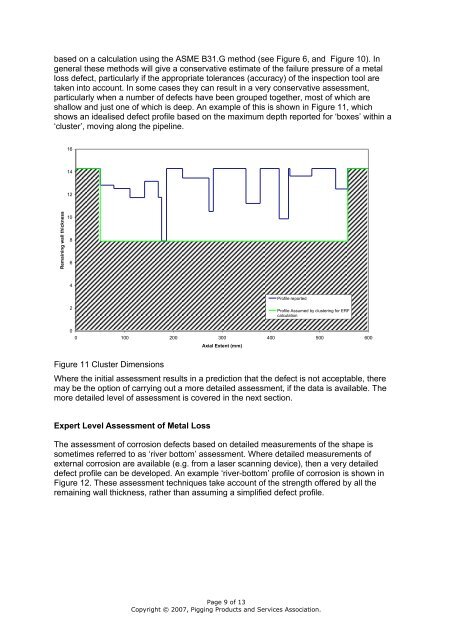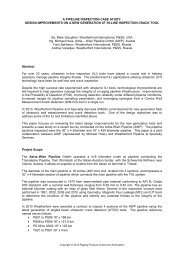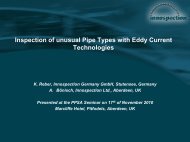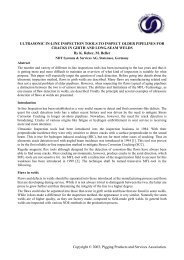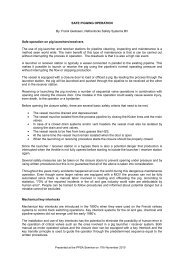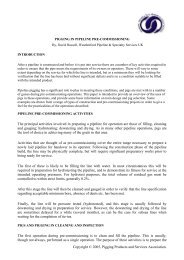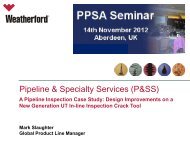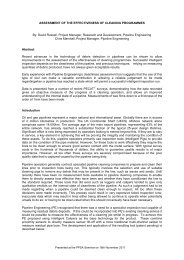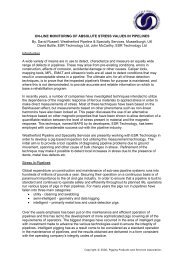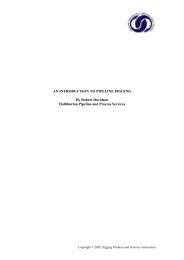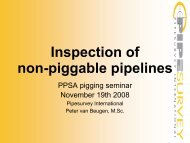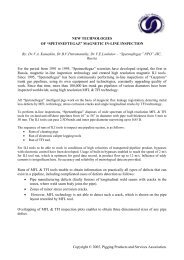Show Paper - PPSA, the Pigging Products and Services Association ...
Show Paper - PPSA, the Pigging Products and Services Association ...
Show Paper - PPSA, the Pigging Products and Services Association ...
Create successful ePaper yourself
Turn your PDF publications into a flip-book with our unique Google optimized e-Paper software.
ased on a calculation using <strong>the</strong> ASME B31.G method (see Figure 6, <strong>and</strong> Figure 10). In<br />
general <strong>the</strong>se methods will give a conservative estimate of <strong>the</strong> failure pressure of a metal<br />
loss defect, particularly if <strong>the</strong> appropriate tolerances (accuracy) of <strong>the</strong> inspection tool are<br />
taken into account. In some cases <strong>the</strong>y can result in a very conservative assessment,<br />
particularly when a number of defects have been grouped toge<strong>the</strong>r, most of which are<br />
shallow <strong>and</strong> just one of which is deep. An example of this is shown in Figure 11, which<br />
shows an idealised defect profile based on <strong>the</strong> maximum depth reported for ‘boxes’ within a<br />
‘cluster’, moving along <strong>the</strong> pipeline.<br />
16<br />
14<br />
12<br />
Remaining wall thickness<br />
10<br />
8<br />
6<br />
4<br />
Profile reported<br />
2<br />
Profile Assumed by clustering for ERF<br />
calculation<br />
0<br />
0 100 200 300 400 500 600<br />
Axial Extent (mm)<br />
Figure 11 Cluster Dimensions<br />
Where <strong>the</strong> initial assessment results in a prediction that <strong>the</strong> defect is not acceptable, <strong>the</strong>re<br />
may be <strong>the</strong> option of carrying out a more detailed assessment, if <strong>the</strong> data is available. The<br />
more detailed level of assessment is covered in <strong>the</strong> next section.<br />
Expert Level Assessment of Metal Loss<br />
The assessment of corrosion defects based on detailed measurements of <strong>the</strong> shape is<br />
sometimes referred to as ‘river bottom’ assessment. Where detailed measurements of<br />
external corrosion are available (e.g. from a laser scanning device), <strong>the</strong>n a very detailed<br />
defect profile can be developed. An example ‘river-bottom’ profile of corrosion is shown in<br />
Figure 12. These assessment techniques take account of <strong>the</strong> strength offered by all <strong>the</strong><br />
remaining wall thickness, ra<strong>the</strong>r than assuming a simplified defect profile.<br />
Page 9 of 13<br />
Copyright © 2007, <strong>Pigging</strong> <strong>Products</strong> <strong>and</strong> <strong>Services</strong> <strong>Association</strong>.


